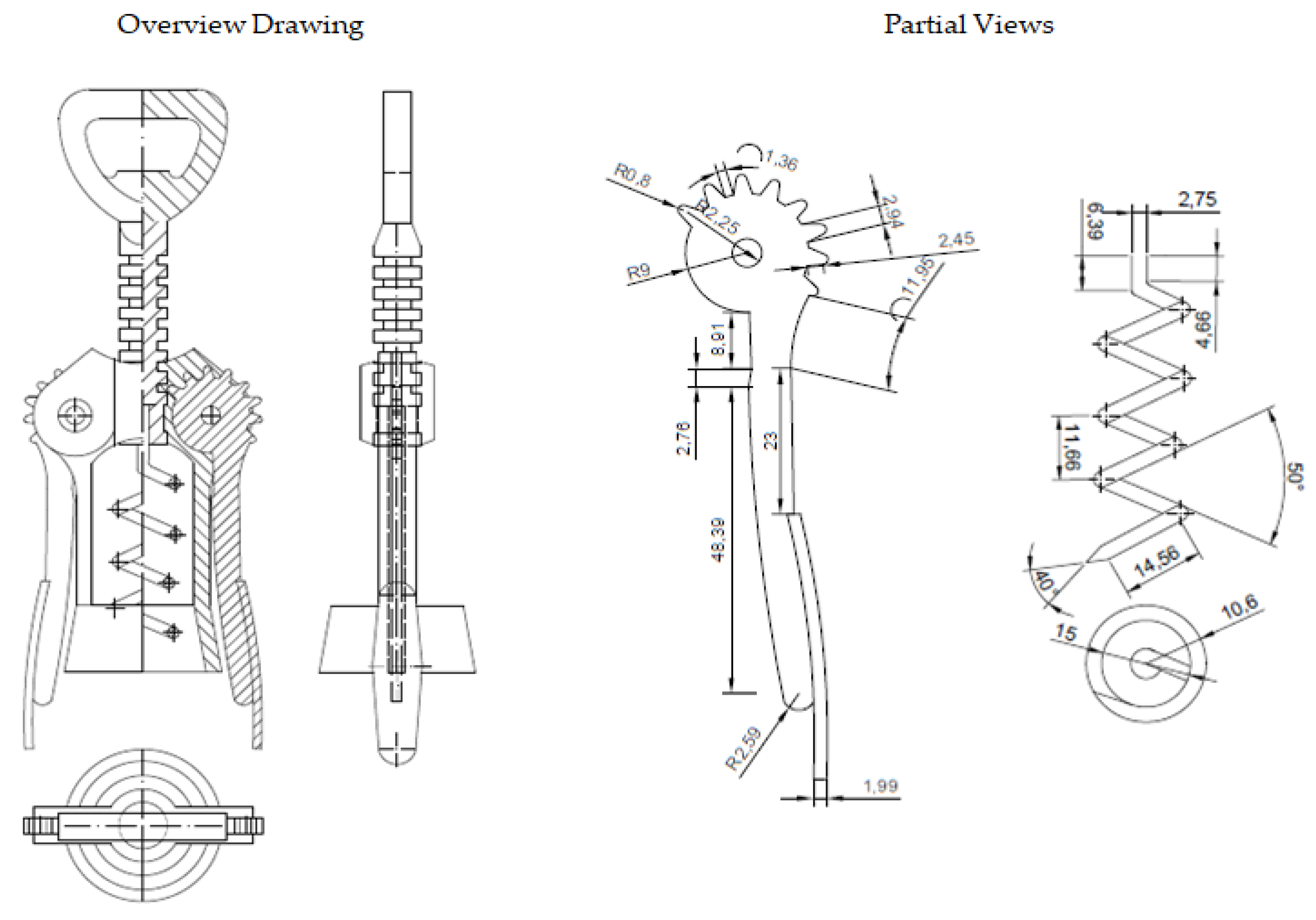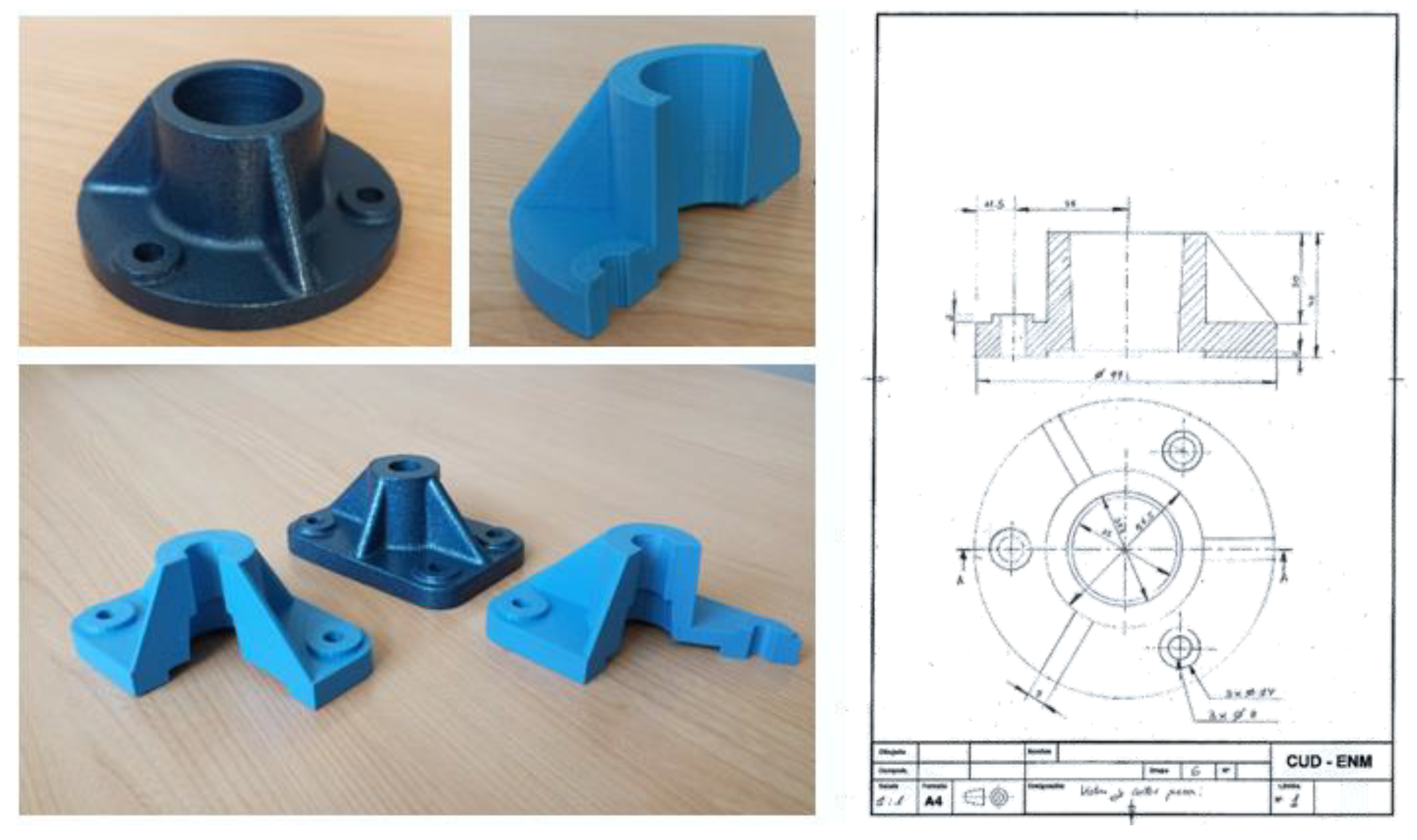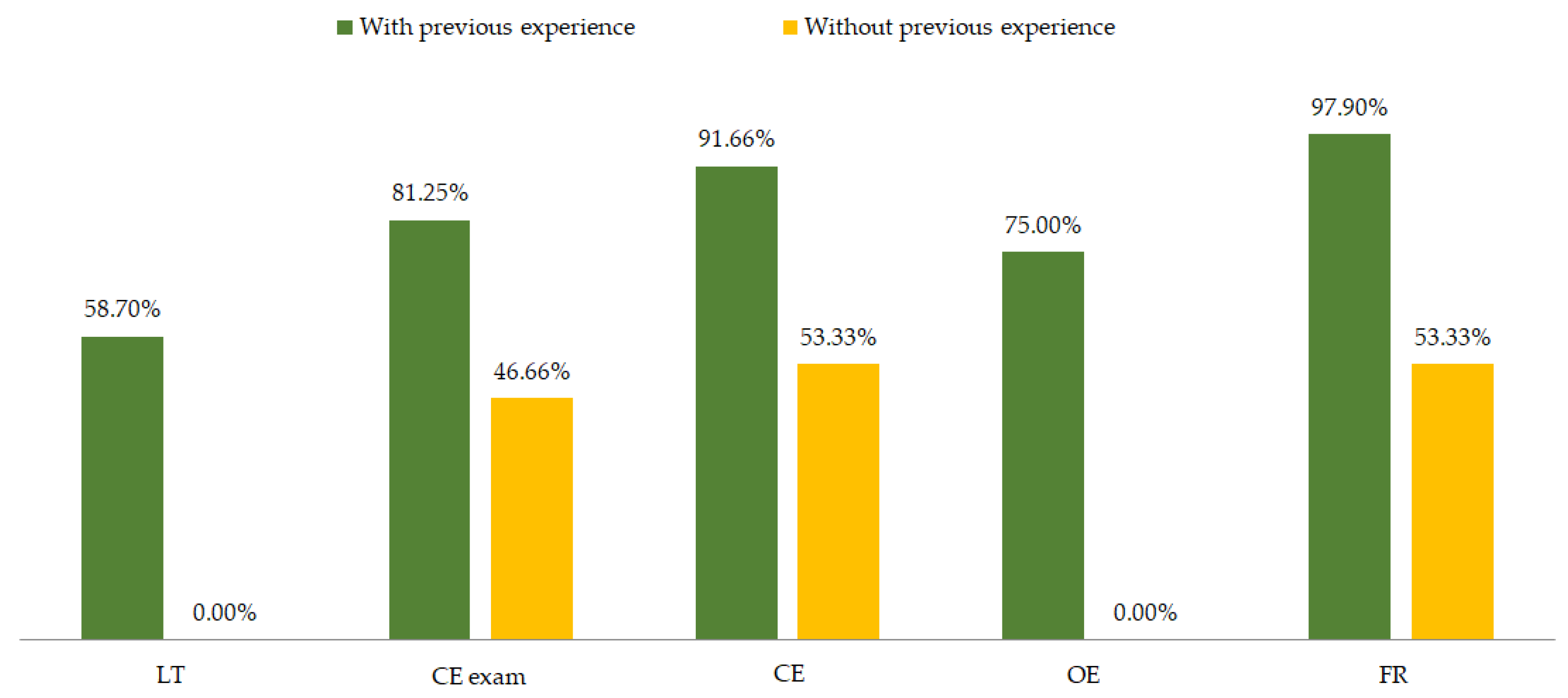Experiences of Inclusive Teaching of Graphic Expression in the Context of Mechanical Engineering †
Abstract
:1. Introduction
2. Materials and Methods
- Level test, to assess prior knowledge and abilities of the students to identify the differences in knowledge and the poorest capabilities, which allows us to define the learning activities with precision.
- Zero course, to introduce briefly the most important basic concepts required to face the subject in good conditions. It is usually carried out in the first weeks of the term.
- Group work task: the project. Students, whether or not they have knowledge or previous experience, work by groups in the elaboration of a document that includes a brief introduction and, mainly, the plans (2D standard views and perspectives like axonometric system) of a simple machine and its parts (Figure 1). Then, each student must present the results and his contribution to teachers and classmates.
- 4.
- 3D printer for improving spatial visualization. Task of converting a 3D part into several 2D views (Figure 2), helped for versions of these parts sectioned in different ways to achieve a better understanding. These sectioned parts can be obtained from the original part by 3D printer and the students can measure the different details easier than over the original. It is possible to consider this and previous tasks like inclusive activities (except the zero course) because the students work together adapting the learning tool to their needs.
- 5.
- Partial and final exams and other assessments, required to grade students, but useful to know the effectiveness of the teaching-learning methodologies employed.
- 6.
- Satisfaction surveys to know the success and level of satisfaction of the students with the inclusive activities planned to help them with learning. Two surveys, one about the satisfaction with the group work project and the other one about the 3D printer activity, were done. The level of satisfaction was measured using a Likert rating scale, from 1 to 5 points, being the 1 for “nothing” and the 5 for “complete”.
3. Results and Discussion
3.1. Level Test
- Any student without previous experience passed the level test. The best mark obtained by this group of students was lower than 3 points (scored over 10).
- 58% of the students with previous experience passed the level test.
- 31% of the students with previous experience who did not pass the test obtained a mark between 4 and 5 points.
- The most difficult content, for students with previous experience, is dihedral system.
3.2. Exam Tasks and Results
3.3. Satisfaction Surveys
4. Conclusions
Author Contributions
Acknowledgments
Conflicts of Interest
References
- Álvarez-Caldas, C.; Quesada, A.; Calvo, J.A.; San Román, J.L. Aplicación interactiva para la docencia de los fundamentos del sistema diédrico. In Proceedings of the Congreso Ibero-Americano de Ingeniería Mecánica (CIBEM), Porto, Portugal, 4–7 September 2011; Natal Jorge, R.M., Tavares, J.M.R.S., Alexandre, J.L., Ferreira, A.J.M., Vaz, M., Eds.; Facultade de Engenheria da Universidade de Porto: Porto, Portugal, 2011. [Google Scholar]
- Gardner, H. Frames of Mind: The Theory of Multiple Intelligences, 3rd ed.; Basic books: New York, NY, USA, 2011. [Google Scholar]
- Strong, S.; Smith, R. Fundamentals and Trends in Engineering Graphics. J. Ind. Technol. 2001, 18. Available online: https://cdn.ymaws.com/www.atmae.org/resource/resmgr/JIT/strong122001.pdf (accessed on 25 May 2018).
- Mataix San Juán, J. La Habilidad Espacial en los Estudiantes de Carreras Técnicas. Desarrollo, Medida y Evaluación en el Marco del Espacio Europeo de Educación Superior. Ph.D. Thesis, Universidad de Córdoba, Córdoba, Spain, 2014. [Google Scholar]
- Burnett, S.A.; Lane, D.M. Effects of academic instruction on spatial visualization. Intelligence 1980, 4, 233–242. Available online: http://www.sciencedirect.com/science/article/pii/0160289680900215 (accessed on 25 May 2018). [CrossRef]
- Mix, K.S.; Cheng, Y.L. The Relation between Space and Math. Developmental and Educational Implications. Adv. Child Dev. Behav. 2012, 42, 197–243. [Google Scholar] [CrossRef] [PubMed]
- Saorín-Pérez, J.L.; Navarro-trujillo, J.L.; Martín-Dorta, N.; Martín-Gutierrez, J.; Contero, M. La capacidad especial y su relación con la ingeniería. DYNA Ing. Ind. 2009, 84, 731–732. [Google Scholar]
- European Commission, Directorate General for Education and Culture (Ed.) Education and Training in EUROPE: Diverse Systems, Shared Goals for 2010; The work programme on the future objectives of education and training systems; European Commission, Directorate General for Education and Culture: Brussel, Belgium, 2002. [Google Scholar]



| Question | Students with Previous Experience (Scored over 5) | Students without Previous Experience (Scored over 5) |
|---|---|---|
| What was your ability for spatial visualization and your knowledge about standards of technical drawing before starting this subject? | 3.6 | 1.3 |
| How many important was the realization of the project (group work) to improve your knowledge of standards in drawing? | 3.1 | 3.2 |
| Grade the utility of the project-based learning in comparison with traditional learning methods. | 3.1 | 3.1 |
| Grade the contribution of the activity to the group work competence. | 3.5 | 3.9 |
| Grade the utility of the seminar of standard views using 3D printed to improve your spatial visualization abilities. | 3.3 | 3.9 |
Publisher’s Note: MDPI stays neutral with regard to jurisdictional claims in published maps and institutional affiliations. |
© 2018 by the authors. Licensee MDPI, Basel, Switzerland. This article is an open access article distributed under the terms and conditions of the Creative Commons Attribution (CC BY) license (https://creativecommons.org/licenses/by/4.0/).
Share and Cite
Casqueiro, C.; Solla, M.; Núñez-Nieto, X.; Carreño, R. Experiences of Inclusive Teaching of Graphic Expression in the Context of Mechanical Engineering. Proceedings 2018, 2, 1337. https://doi.org/10.3390/proceedings2211337
Casqueiro C, Solla M, Núñez-Nieto X, Carreño R. Experiences of Inclusive Teaching of Graphic Expression in the Context of Mechanical Engineering. Proceedings. 2018; 2(21):1337. https://doi.org/10.3390/proceedings2211337
Chicago/Turabian StyleCasqueiro, Carlos, Mercedes Solla, Xavier Núñez-Nieto, and Rafael Carreño. 2018. "Experiences of Inclusive Teaching of Graphic Expression in the Context of Mechanical Engineering" Proceedings 2, no. 21: 1337. https://doi.org/10.3390/proceedings2211337
APA StyleCasqueiro, C., Solla, M., Núñez-Nieto, X., & Carreño, R. (2018). Experiences of Inclusive Teaching of Graphic Expression in the Context of Mechanical Engineering. Proceedings, 2(21), 1337. https://doi.org/10.3390/proceedings2211337






